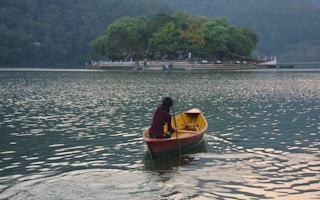Two years ago, as he arrived to check a mountain trout fishing centre he owned near the Tibetan border, Gyanendra Kachhapati noticed the Melamchi river flooding, despite a clear sky.
He quickly sent his son racing home on a motorcycle to warn his wife and others living downstream. They survived the rapidly growing deluge - but Kachhapati was not so lucky.
“I came home to save mom at my father’s direction, because our home was on the Melamchi riverbank,” his 29-year-old son Upendra Kachhapati remembers.
But as father and son spoke via mobile phone, Gyanendra “was swept away while talking,” his son said - one of five people killed near the riverside centre that day.
Altogether the flood, sparked by a glacial lake collapse near the Tibetan border, claimed 24 lives and damaged about US$905 million in infrastructure, including 570 homes, according to Nepal’s National Disaster Risk Reduction and Management Authority.
As climate change heats the planet, making rainfall more extreme and accelerating the melting of glaciers, Himalayan nations such as Nepal are facing growing risks from floods, often driven by glacial lake outbursts.
Greater volumes of glacial meltwater are gradually building up in mountain lakes, putting growing pressure on the earth and rock holding them in place. Those can suddenly collapse, spurring huge downstream floods.
While some monitoring equipment and early warning systems are in place to alert downstream communities, a lack of cross-border information sharing among Himalayan nations - among them China, India and Nepal - is handicapping protection efforts, analysts warn.
“Many dangerous glacial lakes are in Tibet. If they burst, it will directly impact Nepal and the damage will be much larger than the Melamchi disaster,” warned Narendra Khanal, a former head of geography at Nepal’s Tribhuvan University.
Dangerous lakes
Northern Nepal borders China for almost 1,400 km (860 miles) and the country’s main rivers - the Koshi, Gandaki and Karnali - flow in from Tibet.
Maps published by the intergovernmental International Centre for Integrated Mountain Development (ICIMOD) and the UN Development Programme (UNDP) show 3,624 glacial lakes along the three river basins in 2020, 2,070 of them in Nepal, 1,509 in China and 45 in India.
“
We are in a difficult position with the lack of data about the glacial lakes. We are always sounding out China and India to provide real-time data in different forums, such as the World Meteorology Forum.
Kamal Ram Joshi, director general, Nepal Department of Hydrology and Meteorology
Of those, 47 are considered at particular risk of outburst, 25 of them in Tibet, the agencies said.
But little real-time information is shared across international borders on the state of the lakes, even as they grow in size, because formal data sharing mechanisms are largely still not in place, analysts said.
That is raising fears in downstream communities, which are themselves growing in size, that killer floods could arrive with little warning.
“We are not serious regarding the disaster of glacial lake outbursts,” said Deepak K.C., a climate change resilience expert with UNDP in Kathmandu.
The 2016 collapse of a one-hectare glacial lake in Tibet caused US$200 million in damage along the Bhote Koshi river system in Nepal, he said, sweeping away 125 homes and a hydropower plant, though not causing any deaths.
But “other lakes are 200 times larger than that one and can explode at any time. What will be our situation when that happens?” he asked.
Asking for data
As the danger from Himalayan glacial lakes grows, researchers and officials have sought more formal sharing of lake data and early warnings among Nepal, China and India, they said.
Kamal Ram Joshi, director general of Nepal’s Department of Hydrology and Meteorology, said his agency had requested real-time data on the status of glacial lakes on shared river systems from China and India but had so far not had a positive response.
“We are in a difficult position with the lack of data about the glacial lakes,” he said, noting that the agency had not sought historical data, only real-time readings.
“We are always sounding out China and India to provide real-time data in different forums, such as the World Meteorology Forum,” he said.
Rishi Ram Sharma, a former director of the hydrology and meteorology department until 2019, said the agency had made requests to China as far back as his time in office.
One challenge appears to be the political sensitivity of data from Tibet, researchers said.
China has provided some help, alerting by email the chief of Nepal’s Dolakha district in June 2021 about a blockage on China’s Tamakoshi river due to large-scale landslides, said Ranjan Kumar Dahal, an associate geography professor at Tribhuvan University.
That warning, passed on to downstream communities, saved lives, he said.
Khanal, of Tribhuvan University, said Nepal should work harder to try to secure a regular stream of such needed information.
“Chinese scientists have said to us the Nepal government should take initiatives. I think the Nepal government is also not serious about it,” he said.
Money may be part of the problem, with provider countries sometimes requiring payment for data, Khanal said.
Downstream risk
Residents along cross-borders rivers say better data sharing cannot come too soon.
Nima Gyalzen Sherpa, chairperson of the Helambu rural municipality, which has asked Nepal’s government to push for more international information sharing, said warnings that came even a half hour before a flood could substantially cut losses.
“We could inform residents of the Melamchi riverbank. At least human life would be safe,” he said.
Upendra Kachhapati, the son of the man killed at the fishing centre during the Melamchi flood, said for now residents remain in the dark.
“What time a flood comes from the Himalayan region, we cannot predict,” he said. What is happening in the high Himalayas? We need information.”
This story was published with permission from Thomson Reuters Foundation, the charitable arm of Thomson Reuters, that covers humanitarian news, climate change, resilience, women’s rights, trafficking and property rights. Visit https://www.context.news/.

















